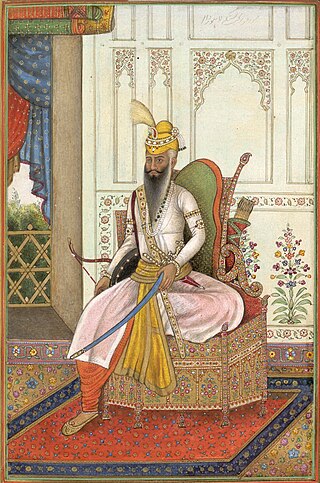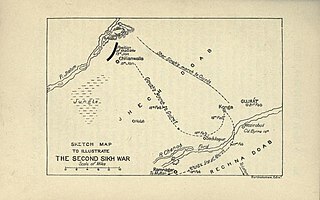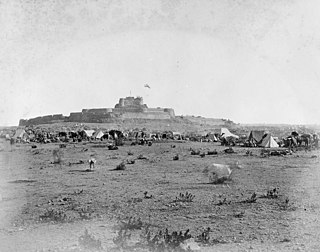
The Durrani Empire or the Afghan Empire, also known as the Sadozai Kingdom, was an Afghan empire that was founded by Ahmad Shah Durrani in 1747, that spanned parts of Central Asia, the Iranian plateau, and the Indian Subcontinent. At its peak, it ruled over the present-day Afghanistan, much of Pakistan, parts of northeastern and southeastern Iran, eastern Turkmenistan, and northwestern India. Next to the Ottoman Empire, the Durrani Empire is considered to be among the most significant Islamic Empires of the 18th century.

Ranjit Singh, popularly known as Sher-e-Punjab or "Lion of Punjab", was the first Maharaja of the Sikh Empire, which ruled the northwest Indian subcontinent in the early half of the 19th century. He survived smallpox in infancy but lost sight in his left eye. He fought his first battle alongside his father at age 10. After his father died around Ranjit's early teenage years, Ranjit subsequently fought several wars to expel the Afghans throughout his teenage years. At the age of 21, he was proclaimed the "Maharaja of Punjab". His empire grew in the Punjab region under his leadership through 1839.

The second Anglo-Sikh war was a military conflict between the Sikh Empire and the East India Company which took place from 1848 to 1849. It resulted in the fall of the Sikh Empire, and the annexation of the Punjab and what subsequently became the North-West Frontier Province, by the East India Company.

Kasur is a city to the south of Lahore, in the Pakistani province of Punjab. The city serves as the headquarters of Kasur District. Kasur is the 16th largest city in Punjab and 24th largest in Pakistan, by population. It is also known for being the burial place of the 17th-century Sufi-poet Bulleh Shah. It is farther west of the border with neighboring India, and bordered to Lahore, Sheikhupura and Okara Districts of Punjab. The city is an aggregation of 26 fortified hamlets overlooking the alluvial valleys of the Beas and Sutlej rivers.

The North-West Frontier was a region of the British Indian Empire. It remains the western frontier of present-day Pakistan, extending from the Pamir Knot in the north to the Koh-i-Malik Siah in the west, and separating the modern Pakistani frontier regions of North-West Frontier Province, Federally Administered Tribal Areas and Balochistan from neighbouring Afghanistan in the west. The borderline between is officially known as the Durand Line and divides Pashtun inhabitants of these provinces from Pashtuns in eastern Afghanistan.

The Sikh Empire was a regional power based in the Punjab region of the Indian subcontinent. It existed from 1799, when Maharaja Ranjit Singh captured Lahore, to 1849, when it was defeated and conquered by the British East India Company in the Second Anglo-Sikh War. It was forged on the foundations of the Khalsa from a collection of autonomous misls. At its peak in the 19th century, the empire extended from Gilgit and Tibet in the north to the deserts of Sindh in the south and from the Khyber Pass in the west to the Sutlej in the east as far as Oudh. It was divided into four provinces: Lahore, which became the Sikh capital; Multan; Peshawar; and Kashmir from 1799 to 1849. Religiously diverse, with an estimated population of 4.5 million in 1831, it was the last major region of the Indian subcontinent to be annexed by the British Empire.
Jamrūd or Jam is a town in the Khyber District of Khyber Pakhtunkhwa, Pakistan. Located in the Valley of Peshawar, on the western fringe of Peshawar city, Jamrud is the doorway to the Khyber Pass which is just to the west of the town. The pass connects Jamrud with Landi Kotal to the west, located near the border of Afghanistan's Nangarhar Province.

Hari Singh Nalwa was Commander-in-chief of the Sikh Khalsa Fauj, the army of the Sikh Empire. He is known for his role in the conquests of Kasur, Sialkot, Attock, Multan, Kashmir, Peshawar and Jamrud. Hari Singh Nalwa was responsible for expanding the frontier of Sikh Empire to beyond the Indus River right up to the mouth of the Khyber Pass. At the time of his death, the western boundary of the empire was Jamrud.

The Durrani dynasty was founded in 1747 by Ahmad Shah Durrani at Kandahar, Afghanistan. He united the different Pashtun tribes and created the Durrani Empire. which at its peak included the modern-day Afghanistan, Pakistan, as well as some parts of northeastern Iran, eastern Turkmenistan, and northwestern India including the Kashmir Valley.

The Battle of Jamrud was fought between the Emirate of Afghanistan under Emir Dost Mohammad Khan and the Sikh Empire under Maharaja Ranjit Singh on 30 April 1837. Afghan forces confronted the Sikh forces at Jamrud. The garrisoned army was able to hold off the Afghans till Sikh reinforcements arrived to relieve them.

The Jamrud Fort is located beside Bab-e-Khyber at the entrance to the Khyber Pass from the Peshawar side in the tribal district of Khyber KPK, Pakistan. After death of Sardar General Hari Singh Nalwa, Khalsa Sarkar Wazir Jawahar Singh nominated Sardar General Gurmukh Singh Lamba as chief administrative and military commander to restore and consolidate the Khalsa army gains. General Sardar Gurmukh Singh Lamba was nominated as chief administrative and military commander to consolidate the gains of Khalsa Sarkar.

The Sikh diaspora is the modern Sikh migration from the traditional area of the Punjab region of South Asia. Sikhism is a religion native to this region. The Sikh diaspora is largely a subset of the Punjabi diaspora.

The Battle of Nowshera was fought in Nowshera in March 1823 between the Yusufzai Afghans, supported by the Peshawar sardars, alongside Azim Khan Barakzai, the Afghan governor of Peshawar, where they would face the Sikh armies led by Maharaja Ranjit Singh. Azim Khan was a half-brother of Dost Mohammad Khan, future ruler of Kabul, and later Afghanistan. The battle was a victory for the Sikhs, successfully defeating Azim Khan's armies. This victory allowed them to begin to their occupation of the Peshawar Valley.

The Afghan–Sikh wars spanned from 1748 to 1837 in the Indian subcontinent, and saw multiple phases of fighting between the Durrani Empire and the Sikh Empire, mainly in and around Punjab region. The conflict's origins stemmed from the days of the Dal Khalsa, and continued after the Emirate of Kabul succeeded the Durrani Empire.

The Afghan-Maratha War was fought between the Afghan Empire under Ahmad Shah Durrani and the Maratha Empire and the Sikh Confederacy between 1758 and 1761. It took place in north-west India, primarily the region around Delhi and Punjab.

Timur Shah Durrani, also known as Timur Shah Abdali or Taimur Shah Abdali was the second ruler of the Afghan Durrani Empire, from November 1772 until his death in 1793. An ethnic Pashtun, he was the second eldest son of Ahmad Shah Durrani.

Ahmad Shah Durrani, the founder of the Durrani Empire, invaded Indian subcontinent for eight times between 1748 and 1767, following the collapse of Mughal Empire in the mid-18th century. His objectives were met through the raids and deepened the political crisis in India.
The Battle of Sialkot was fought between Durrani Empire and Sukerchakia Misl of Dal Khalsa in 1761.
Punjabis in Afghanistan were residents of Afghanistan who were of Punjabi ancestry. There was historically a small Punjabi community in the country, mainly consisting of Afghan Sikhs and Hindus.
















